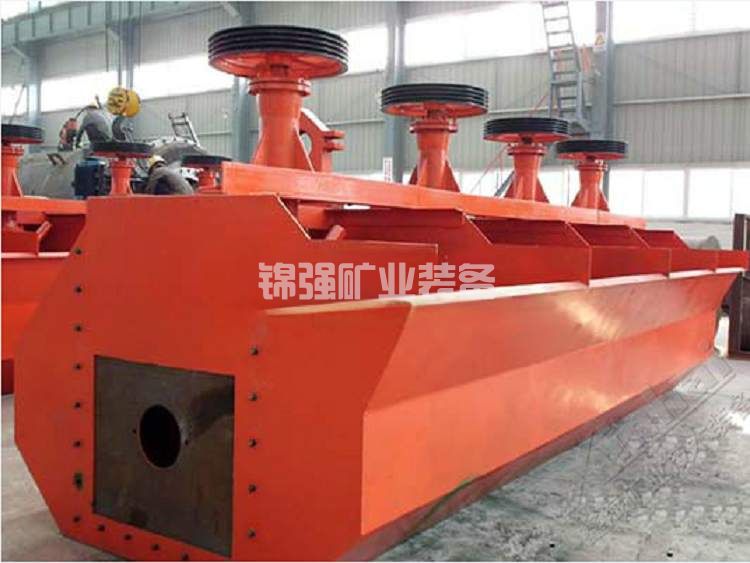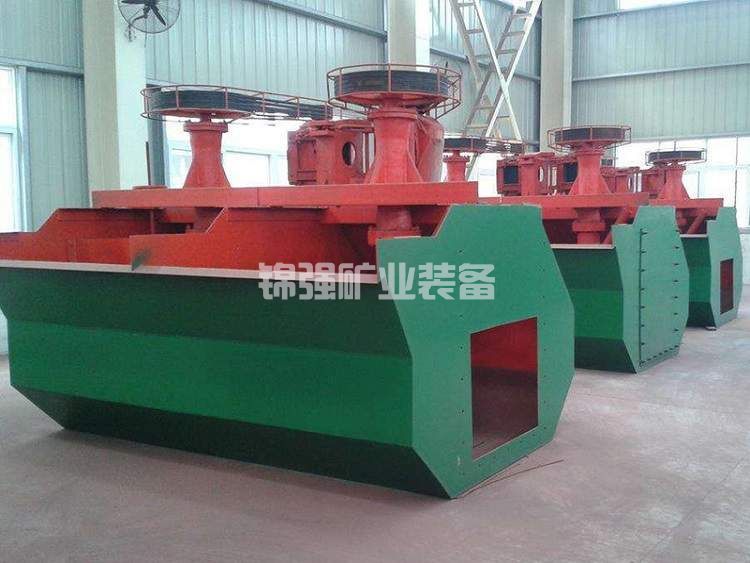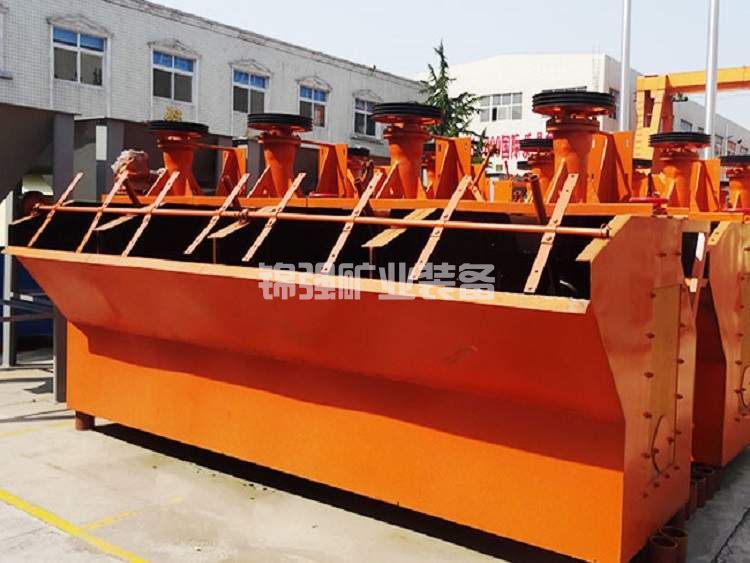 Service Phone:
+8619870423316
Service Phone:
+8619870423316
 Service Phone:+8619870423316
Service Phone:+8619870423316
current location: home > News and information > Flotation knowledge
update date:2023-07-16 03:22:17Number of views: author:admin
In the process of beneficiation, lead-zinc ore is mainly flotation, and the flotation methods of lead-zinc sulfide ore and lead-zinc oxide ore are different. The following are two flotation processes for lead-zinc ore. Under normal conditions, the flotation process of lead-zinc sulfide ore mainly includes traditional flotation process and potential regulation flotation process, including preferential flotation, mixed flotation, flotation and asynchronous flotation process.
1. The preferential flotation process of lead-zinc sulfide ores.
Priority flotation of lead zinc ore often uses the method of first suppressing zinc flotation and then activating zinc to obtain the final lead and zinc concentrates. After grinding the mineral to the required particle size, use a strong collector to flotation lead with high alkalinity, add excess lime and xanthate, and adjust the pH value of the slurry; 12, inhibit the newly dissociated Pyrite, protect the newly dissociated Galena surface with xanthate, and then preferentially flotation to recover lead; Activating flotation tailings with Copper(II) sulfate, recovering Zinc sulfide coarse concentrate with butyl xanthate, and selecting coarse concentrate under high alkali conditions to obtain zinc concentrate; After thickening the zinc tailings, they are activated with sulfuric acid and the sulfur concentrate is recovered with xanthate. The preferential flotation process of lead-zinc sulfide ore is mainly applicable to lead-zinc ore with simple mineral processing composition, high grade of raw ore lead-zinc, large floatability difference of lead-zinc ore, and coarse embedded particle size.
2. Mixed flotation process of lead zinc sulfide ores.
Mixed flotation of lead-zinc sulfide ore is to mix flotation of lead and zinc first, and then separate lead and zinc. The xanthate or black powder is used as the collector to flotation the lead sulfide ore and part of Zinc sulfide ore at the same time without adjusting the pH value of the pulp to obtain a mixed concentrate of lead and zinc. The tailings in the flotation process are activated with Copper(II) sulfate, and xanthate is used as the collector for mixed flotation to obtain zinc sulfur mixed concentrate, which is then separated by lime and cyanide flotation to obtain zinc concentrate and sulfur concentrate. The mixed flotation process of lead-zinc sulfide ore is suitable for processing lead-zinc ores. The floatability difference is small, the grade is low, and the useful minerals are aggregates or dense symbiosis.
3. Asynchronous flotation process of lead-zinc sulfide ores.
Asynchronous flotation of lead-zinc sulfide ore is different from waiting for flotation to make lead float all at once, while allowing zinc and sulfur with similar floatability to float at the same time. Asynchronous flotation is to gradually create suitable flotation conditions for Galena and Sphalerite in different operations, and simultaneously flotation lead and zinc. Asynchronous flotation of lead-zinc sulfide ores is suitable for handling fine grained lead-zinc ores.
4. Potential regulation flotation process of lead-zinc sulfide ore.
The potential regulation flotation of lead zinc sulfide ore is to control the Redox process and even direction of sulfide mineral surface in the pulp system by changing the electrochemical conditions of the flotation system, affect the Surface states of sulfide minerals and the product form and stability of collectors on the surface of sulfide minerals, increase the hydrophilicity and hydrophobicity of sulfide mineral surface, and achieve selective flotation separation of sulfide minerals. The whole agent of lime and the combined inhibitor Zinc sulfate+Sodium sulfite are added to the ball mill to complete the selective flotation and separation of Galena, Sphalerite and Pyrite under the high alkaline pulp environment and low oxidation potential.
The potential regulation flotation process of lead-zinc sulfide ore is suitable for the separation of low-grade lead-zinc sulfide ore.
Lead zinc oxide ore has a high oxide content, fragile performance, and is prone to cracking during mining. And this mineral composition is complex and difficult to choose from. At present, common beneficiation processes include Sodium oxide sulfuration flotation, sulfur sulfuration flotation, flocculation flotation, heavy flotation combined selection, etc.
1. Sodium oxide sulfuration flotation process of lead and zinc oxide ores.
The floatability of oxidized lead zinc ore is low, and conventional collectors are difficult to flotation to produce oxidized lead zinc ore with high indicators. Generally, sulfide xanthate flotation and sulfide amine flotation are used.
Sulfidation xanthate flotation: after the zinc oxide mineral is sulfurized by Sodium sulfide, Copper(II) sulfate is added as an activator, and the high-grade xanthate collector is used for flotation. Sulfurizer flotation of lead zinc oxide ore is suitable for treating lead oxide minerals.
Sulfide amine flotation: zinc oxide mineral is sulfurized by Sodium sulfide and then floated with fatty amine collector. Sulfide amine flotation of zinc oxide ore is suitable for treating zinc oxide ore containing easily sliming gangue, but the process is complex and requires desliming equipment, which can only be achieved with a large amount of sulfuric acid cleaning and activation.
2. Sulfur sulfide flotation process for oxidized lead zinc ore.
Sulfur sulfurization flotation is the use of sulfur powder to sulfurize lead-zinc oxide ore. After sulfurization, a sulfide film will form on the surface of the mineral, thereby achieving the separation of lead-zinc oxide ore. However, this process can only be achieved under high temperature and pressure conditions and is currently rarely used.
3. Flocculation flotation process for oxidized lead zinc ore.
Flocculation flotation of oxidized lead zinc ore involves strongly stirring high molecular compound hydrophobic particulate minerals and then adding collectors for flotation. Flocculation flotation is suitable for the selection of particulate oxidized lead zinc ore. However, due to the high difficulty and cost of developing polymer flocculants, they have not yet been applied in practice.
4. Combined selection process for heavy flotation of oxidized lead zinc ore.
Due to the unique nature of the ore, some oxidized lead zinc ores sometimes adopt a combination of gravity separation and flotation selection process to achieve the goal of comprehensive recovery of useful minerals. Re select or recover minerals with high density or magnetism, or use pre tailings for re selection. The combined selection of heavy flotation is suitable for minerals with a significant difference in density between metal minerals and gangue minerals, or minerals with magnetic properties.
The above are common flotation processes for lead-zinc ores. The flotation process varies depending on the nature and degree of oxidation of the ore. Therefore, it is recommended that the ore owner conduct beneficiation experiments, customize a scientific and reasonable lead zinc ore flotation process through the test report, improve flotation indicators, and reduce economic losses.


 Introduction to the flotation process of lead-zinc ore
Introduction to the flotation process of lead-zinc ore
 The difference between energy-saving bal
The difference between energy-saving bal The drawbacks of difficult selection and
The drawbacks of difficult selection and Introduction to the characteristics of d
Introduction to the characteristics of d Types of mining magnetic separation equi
Types of mining magnetic separation equi What is the price of the Hesha magnetic
What is the price of the Hesha magnetic  The dry magnetic separator is applicable
The dry magnetic separator is applicable The price of dry magnetic separators is
The price of dry magnetic separators is  Selection range of fly ash magnetic sepa
Selection range of fly ash magnetic sepa Magnetic field intensity division of mag
Magnetic field intensity division of mag Different factors affecting the price of
Different factors affecting the price of How to achieve better magnetic separatio
How to achieve better magnetic separatio Industrial types and requirements of man
Industrial types and requirements of man Cement grinding process flow of ball mil
Cement grinding process flow of ball mil Optimization and Improvement of Wollasto
Optimization and Improvement of Wollasto Production process and main equipment of
Production process and main equipment of Complete set of beneficiation equipment
Complete set of beneficiation equipment  Complete equipment for quartz sand benef
Complete equipment for quartz sand benef Complete equipment for graphite ore bene
Complete equipment for graphite ore bene Complete set of beneficiation equipment
Complete set of beneficiation equipment  Complete set of mining beneficiation equ
Complete set of mining beneficiation equ Complete energy-saving beneficiation equ
Complete energy-saving beneficiation equ Complete set of manganese ore beneficiat
Complete set of manganese ore beneficiat Gold selection complete equipment
Gold selection complete equipment Complete beneficiation equipment
Complete beneficiation equipment Complete set of sand gold beneficiation
Complete set of sand gold beneficiation  Complete set of Baryte beneficiation equ
Complete set of Baryte beneficiation equ Complete beneficiation equipment for cop
Complete beneficiation equipment for cop Complete set of iron ore equipment
Complete set of iron ore equipment Complete machine for iron ore beneficiat
Complete machine for iron ore beneficiat Complete beneficiation production line
Complete beneficiation production line